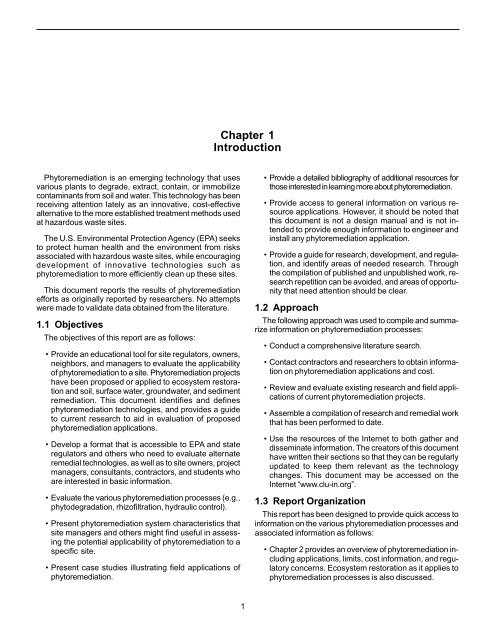Introduction to Phytoremediation - CLU-IN
Introduction to Phytoremediation - CLU-IN
Introduction to Phytoremediation - CLU-IN
You also want an ePaper? Increase the reach of your titles
YUMPU automatically turns print PDFs into web optimized ePapers that Google loves.
Phy<strong>to</strong>remediation is an emerging technology that uses<br />
various plants <strong>to</strong> degrade, extract, contain, or immobilize<br />
contaminants from soil and water. This technology has been<br />
receiving attention lately as an innovative, cost-effective<br />
alternative <strong>to</strong> the more established treatment methods used<br />
at hazardous waste sites.<br />
The U.S. Environmental Protection Agency (EPA) seeks<br />
<strong>to</strong> protect human health and the environment from risks<br />
associated with hazardous waste sites, while encouraging<br />
development of innovative technologies such as<br />
phy<strong>to</strong>remediation <strong>to</strong> more efficiently clean up these sites.<br />
This document reports the results of phy<strong>to</strong>remediation<br />
efforts as originally reported by researchers. No attempts<br />
were made <strong>to</strong> validate data obtained from the literature.<br />
1.1 Objectives<br />
The objectives of this report are as follows:<br />
• Provide an educational <strong>to</strong>ol for site regula<strong>to</strong>rs, owners,<br />
neighbors, and managers <strong>to</strong> evaluate the applicability<br />
of phy<strong>to</strong>remediation <strong>to</strong> a site. Phy<strong>to</strong>remediation projects<br />
have been proposed or applied <strong>to</strong> ecosystem res<strong>to</strong>ration<br />
and soil, surface water, groundwater, and sediment<br />
remediation. This document identifies and defines<br />
phy<strong>to</strong>remediation technologies, and provides a guide<br />
<strong>to</strong> current research <strong>to</strong> aid in evaluation of proposed<br />
phy<strong>to</strong>remediation applications.<br />
• Develop a format that is accessible <strong>to</strong> EPA and state<br />
regula<strong>to</strong>rs and others who need <strong>to</strong> evaluate alternate<br />
remedial technologies, as well as <strong>to</strong> site owners, project<br />
managers, consultants, contrac<strong>to</strong>rs, and students who<br />
are interested in basic information.<br />
• Evaluate the various phy<strong>to</strong>remediation processes (e.g.,<br />
phy<strong>to</strong>degradation, rhizofiltration, hydraulic control).<br />
• Present phy<strong>to</strong>remediation system characteristics that<br />
site managers and others might find useful in assessing<br />
the potential applicability of phy<strong>to</strong>remediation <strong>to</strong> a<br />
specific site.<br />
• Present case studies illustrating field applications of<br />
phy<strong>to</strong>remediation.<br />
Chapter 1<br />
<strong>Introduction</strong><br />
1<br />
• Provide a detailed bibliography of additional resources for<br />
those interested in learning more about phy<strong>to</strong>remediation.<br />
• Provide access <strong>to</strong> general information on various resource<br />
applications. However, it should be noted that<br />
this document is not a design manual and is not intended<br />
<strong>to</strong> provide enough information <strong>to</strong> engineer and<br />
install any phy<strong>to</strong>remediation application.<br />
• Provide a guide for research, development, and regulation,<br />
and identify areas of needed research. Through<br />
the compilation of published and unpublished work, research<br />
repetition can be avoided, and areas of opportunity<br />
that need attention should be clear.<br />
1.2 Approach<br />
The following approach was used <strong>to</strong> compile and summarize<br />
information on phy<strong>to</strong>remediation processes:<br />
• Conduct a comprehensive literature search.<br />
• Contact contrac<strong>to</strong>rs and researchers <strong>to</strong> obtain information<br />
on phy<strong>to</strong>remediation applications and cost.<br />
• Review and evaluate existing research and field applications<br />
of current phy<strong>to</strong>remediation projects.<br />
• Assemble a compilation of research and remedial work<br />
that has been performed <strong>to</strong> date.<br />
• Use the resources of the Internet <strong>to</strong> both gather and<br />
disseminate information. The crea<strong>to</strong>rs of this document<br />
have written their sections so that they can be regularly<br />
updated <strong>to</strong> keep them relevant as the technology<br />
changes. This document may be accessed on the<br />
Internet “www.clu-in.org”.<br />
1.3 Report Organization<br />
This report has been designed <strong>to</strong> provide quick access <strong>to</strong><br />
information on the various phy<strong>to</strong>remediation processes and<br />
associated information as follows:<br />
• Chapter 2 provides an overview of phy<strong>to</strong>remediation including<br />
applications, limits, cost information, and regula<strong>to</strong>ry<br />
concerns. Ecosystem res<strong>to</strong>ration as it applies <strong>to</strong><br />
phy<strong>to</strong>remediation processes is also discussed.
















